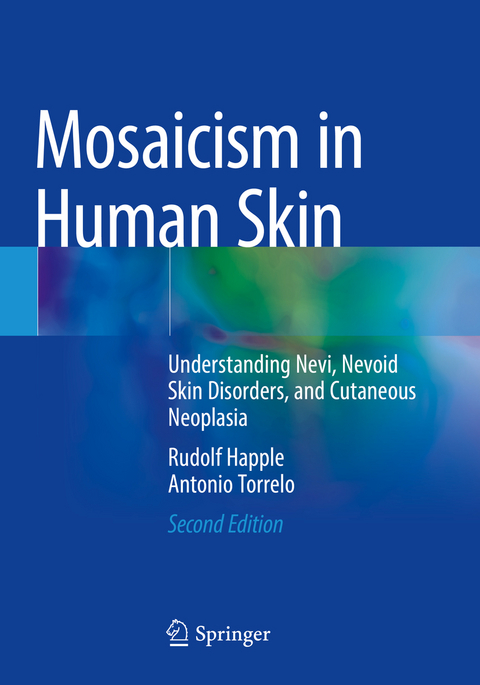
Mosaicism in Human Skin
Springer International Publishing (Verlag)
978-3-030-89939-4 (ISBN)
This second edition offers a fully revised and updated work on a rapidly growing field of knowledge, and was prepared by two experts whose goal was to explain the molecular basis of mosaic skin disorders in a language that is accessible for practicing physicians and medical students alike. It presents a timely and comprehensive overview of the strikingly manifold patterns and peculiarities of mosaic skin disorders in a straightforward, reader-friendly way that will help physicians to further improve genetic counseling and treatment outcomes.
The first two parts of the book are devoted to the mechanisms and patterns of cutaneous mosaicism, and include an explanation of genomic and epigenetic mosaicism and a description of the archetypical segmental patterns including the lines of Blaschko and the flag-like, phylloid and lateralization pattern, the non-segmental pattern of large congenital melanocytic nevi, and the sash-like arrangement as noted in a particular type of cutis tricolor. The concept of lethal mutations surviving as mosaics has now been confirmed by molecular analysis in many sporadically occurring phenotypes. The difference between monoallelic and biallelic traits has deepened our understanding of hereditary mosaics, especially of multiple benign skin tumors. Moreover, recognition of the fundamental difference between the simple segmental and the superimposed types of mosaicism is important for the purpose of genetic counseling. In the third part, the various mosaic skin disorders are examined in depth, including nevi, didymotic disorders, other binary genodermatoses, mosaic manifestations of autosomal skin disorders, and nevoid skin disorders such as phenotypes reflecting functional X-chromosome mosaicism or a superimposed mosaic manifestation of common skin diseases with a polygenic background. Reader-friendly and clearly structured, Mosaicism in Human Skin will appeal to both experienced dermatologists and residents in training, as well as to medical geneticists and pediatricians.
lt;p>Rudolf Happle was born in Freiburg, Germany. In 1986 he was appointed as Chairman, Department of Dermatology, University of Nijmegen, The Netherlands. In 1991 he was appointed as Chairman, Department of Dermatology, University of Marburg, Germany. During his professional career he has functioned as Founding President of the European Society for Pediatric Dermatology, and as President of the European Hair Research Society. Presently he serves as a guest professor at the University Department of Dermatology in Freiburg (Germany). In 2014, his book "Mosaicism in Human Skin" was published by Springer (Berlin). He is an honorary member of the national Dermatological Societies of 16 countries as well as the European Society for Pediatric Dermatology, the Dutch Society for Pediatric Dermatology, and the Sociedad Latinoamericana de Dermatología Pediátrica. He is an elected member of the American Dermatological Association and of the German National Academy of Sciences Leopoldina.
Antonio Torrelo was born in Madrid, Spain. In 1992 he became a Consultant in Pediatric Dermatology at the Hospital Infantil Universitario Niño Jesús in Madrid, Spain, and since 2007 he has headed the Dermatology Department at the same hospital. During his professional career he has served as President of the Spanish Group of Pediatric Dermatology, the International Society of Pediatric Dermatology, and the European Society for Pediatric Dermatology. Dr. Torrelo has acted as Associate Editor of the textbooks 'Pediatric Dermatology' edited by Schachner & Hansen 4th Ed, and 'Dermatology' edited by Bolognia, Schaffer and Cerroni, 4th Ed. He has been Associate Editor of the journal 'Pediatric Dermatology,' and was recently nominated Editor-in-Chief for the new journal JEADV Clinical Practice.
PATTERNS AND MECHANISMS: Mosaicism as a Biological Concept:.- History.- Mosaicism in Plants, Animals, Humans.- Mosaicism Versus Chimerism.- The Mechanisms of Mosaicism .- Genomic Mosaicism of Autosomes.- Epigenetic Mosaicism of autosomes.- Genomic Mosaicism of X Chromosomes.- Epigenetic Mosaicism of X Chromosomes.- The patterns of Mosaicism .- Lines of Blaschko.- Checkerboard Pattern.- Phylloid Pattern.- Patchy Pattern Without Midline Separation.- Lateralization.- Other Patterns, so far Unclassifiable.- MOSAIC SKIN DISORDERS: Nevi.- Melanocytic Nevi.- Other Forms of Pigmentary Mosaicism.- Epidermal Nevi.- Vascular Nevi.- Connective Tissue Nevi.- Nevoid Skin Disorders.- Lyonization (Functional X-Chromosome Mosaicism) in X-Linked Skin Disorders.- Autosomal Non-Nevi.- Neoplastic Skin Lesions.- Benign Tumors.- Malignant Tumors.- CONCLUSION.
| Erscheinungsdatum | 26.11.2023 |
|---|---|
| Zusatzinfo | XIII, 243 p. 244 illus., 218 illus. in color. |
| Verlagsort | Cham |
| Sprache | englisch |
| Maße | 178 x 254 mm |
| Gewicht | 500 g |
| Themenwelt | Medizin / Pharmazie ► Medizinische Fachgebiete ► Dermatologie |
| Schlagworte | Disseminated mosaicism • Epigenetic mosaicism • Functional X-chromosome mosaicism • Genetics • Lethal mutations • Lethal mutations surviving as mosaics • Lines of Blaschko • Nevi • Patterns of segmental mosaicism • Postzygotic mutations • Revertant mosaicism • Single point mosaicism • skin disorders • Type 2 segmental mosaicism |
| ISBN-10 | 3-030-89939-X / 303089939X |
| ISBN-13 | 978-3-030-89939-4 / 9783030899394 |
| Zustand | Neuware |
| Informationen gemäß Produktsicherheitsverordnung (GPSR) | |
| Haben Sie eine Frage zum Produkt? |
aus dem Bereich


